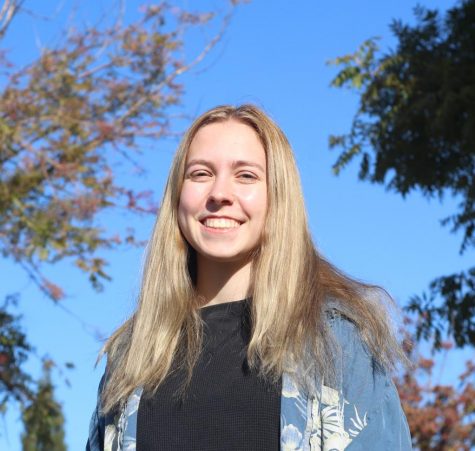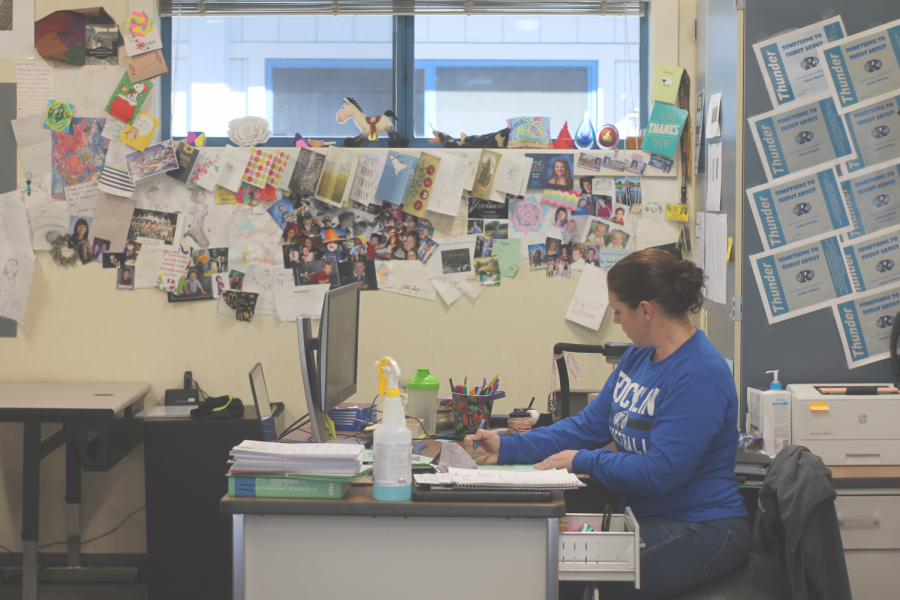A Teacher’s Perspective
A glimpse into the challenges math teachers have faced with distance learning and hybrid teaching
Photo provided by Brianna Peck
“As any person, and as an educator, one of the main goals of education is to make people life-long learners,” shared Michael Trejo, who teaches pre-calculus, AP statistics and Integrated II. “All education starts with trust. Without that trust, it becomes this one-way street of information and there is no give-or-take anymore. Learning then becomes much more difficult.”
Teachers at Rocklin High School have had to seriously adapt since the pandemic began almost a year ago. Math teachers share both their positive and negative experiences from this year, along with the confidence they have in their students.
“It’s very hard. Someone who’s not a teacher might not understand; just being asked to change so often, like when we went on distance learning in the spring, that was such a steep learning curve. Because before, I didn’t have to use my computer to record anything or present anything. I just used my whiteboard. . .” shared Tara McCullough, AP Calculus and Integrated 2 teacher. “I love having my students back; in zoom, I see this tiny box, just this little face, if the camera was even turned on.”
“Being able to make sure they understand everyday, that’s where the time is really important. And it’s not here right now.”
One of the hardest challenges teachers faced, especially over distance learning, was the lack of interaction between them and their students. However, Trejo managed to find a bright side:
“I would say that when we first went to distance learning, I was putting in 12-14 hour days for about a month straight. . . However this [hybrid] semester is still very difficult because there is no back-and-forth with my students. It’s just me talking, and students are reluctant to speak. It’s very lonely. . . I actually got more interaction with students [during distance-learning], then I do now, because I was doing Desmos activities where students could actually type in responses and then send them to me privately. I actually got more information about my students that semester then I do now because of the lack of interaction and speaking.”
With little interaction between themselves and students, teachers have found it harder to gauge whether or not students are understanding the material.
“One of the big challenges when you guys were [at school] every-other day [was] people treating the at-home days as if they were non-participation, like ‘don’t have to do anything days’,” shared Jamie Tippets, who teaches Integrated II and III, “Instead of just being able to move forward and build on it, we’d have to factor in, ‘well half of these guys haven’t seen this so I have to try and touch on it the next day’. So that created some challenges.”
Shortening lectures, making worksheets available online, and full-on cutting materials are adaptations that many teachers have had to make. However, Eshan Taghavi, who teaches Integrated I and SDAIE Integrated math, explains how many dedicated students have been able to adapt well:
“I’ll say this about this year’s freshman, it’s a really, really good group. I’ve been really impressed with them so far. They have been hardworking [and] willing to ask questions, which I think are personality traits that are going to help them a lot moving ahead.”
Although returning to school, via the hybrid system, has made teaching easier, technology has taken on a whole new presence in education.
“It’s forced us to be more creative and it’s forced us to look outside our normals and look at different ways to do things. It’s exhausting, but it’s good. You just wish you had the time to do it,” shared Tippets. “But I can’t master 20 different things, I have to pick two or three that I can use and build from that.”
Taghavi adds on to the new embrace of technology by explaining how it has helped him adapt to a style of teaching that is more comfortable for his students:
“I graduated high school in ‘04 and we didn’t use technology in nearly the same way that you guys do now. So for me teaching was based on how I was taught. But now we are forced to adapt and come into the 21st century, and I think that is going to pay off in the long run because we’ll be able to use the technology that you guys are used to. So that’s a huge advantage in my opinion.”
No matter how many different teaching programs are out there, or how dedicated their students are, the issue of time appears to be the biggest one teachers are facing. By lacking time to quiz students throughout the unit, McCullough shares how she feels students have less time to process the material at-hand.
“Right now, I feel like I am just opening up the kids’ brains and just shoving in as much information as I can. . .I go, ‘Well I hope you guys got that and I’ll cover some homework questions, okay we have time for 2’ and then jump just straight into the next lesson. Being able to make sure they understand everyday, that’s where the time is really important. And it’s not here right now.”
Taghavi added that time is especially important in math since each lesson builds upon the others.
“With 40 minutes or Mondays with, what 30 or 35 minutes? It’s extremely difficult to get everything taught in such a small time frame. By the time you do a warm-up, that’s 5 or 6 minutes done, taking attendance, that another minute, and you know all of these things add up. . .You need time to explain the material, practice it, and then check for understanding. And if there is some sort of issue where it hasn’t been understood the way you want it, you need to be able to go back and re-explain it in a different way. . .I’m sure in other subjects, it can be easier to maybe say, ‘take this home and read it or do this handout’ but in math, the check for understanding. . .is so important.”
Time, technology, connection. Challenges both students and teachers have to face. Yet all teachers share the same ideology: Rocklin students will persevere.
“We’re going to make it work. We’ll find ways to make it work. I’m not worried about the kids, they’ll be fine,” said McCullough.
And finally, Trejo concluded, “Everyone watches out for one another at Rocklin High School, which is a rarity at some schools. And the students are amazing, a lot of teachers complain about the students but I really can’t do that. The students at Rocklin High School do their best, they are amazing kids. They are always so supportive of each other and overall, I think it’s a great place to teach and a great place for students to learn.”




